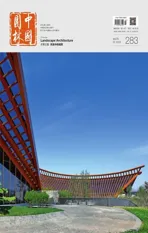刊首语
2019-01-14WANGXiangrong
WANG Xiangrong
宋徽宗酷爱书法和绘画,在位时曾建立宫廷画院,并通过以诗词命题进行创作的方式来筛选画师。据传说,某年的试题是“深山藏古寺”,然而,夺得第一名的画作上根本见不到古寺,只有一和尚在崇山峻岭前的溪水边担水,一条小路隐约从山脚引入深山,如此,“藏”的意境表现达到了极致。
深邃、空灵、委婉、含蓄是中国绘画普遍的艺术特征,不过绝大多数中国的山水画并不会将建筑完全隐藏起来,更多地表现为一种在山水间的若隐若现。或是楼台屋宇掩映在峰峦耸立、云雾缥缈的山间;或是数间房舍散布在巉岩茂林、小径幽深的山谷中;或是雅致的宅邸隐现在层峦叠翠、老树苍劲的山林中;抑或是一方草庐点缀在飞瀑曲溪、江岸水渚之旁。几乎所有的建筑都与山峦、岩石、江河、溪流、树木相伴相随、浑然天成。风景画中都有人物,或是把酒相聚,或是伏案读书,他们的行为及精神似乎也都融入了广阔的风景之中。画面所表现的建筑与风景的关系反映了天地之间人与自然的和谐共生。
从中国传统的山水画作中我们又能体会出另一层含义,那就是中国人欣赏的风景更多的是一种可望、可行、可游、可居的山水——山水是生活之地、游玩之境、聚友之所和冥思之处。在人与自然的关系上,中国美学强调的是二者间的亲密关系。中国人追求的自然是人化的自然,人是自然的朋友。所以在中国,最美的风景中一定会有建筑,建筑赋予了风景以情感和心灵。
山水画是现实风景的理想化,反过来,山水画又影响了中国人认识风景、欣赏风景、经营风景的方式。山水画里的建筑,就是中国人理想中风景建筑的形式。在现实的风景世界里,风景中建筑的设置都是符合山水画的画理的。与无际的风景相比,建筑的规模都非常小,但设计这些建筑时所考虑的范围却远远超越了视野所及。建筑与环境的关系就如同山水画所描绘的那样,建筑不是风景的主角,在画中只占很小的比例,画幅多数的空间都留给了山水。建筑自身的尺度和形态都是非常恰当地依山水环境而定,建筑与风景互相交融,建筑的存在使得风景既可望可行,又可居可游。
建筑与风景互相接纳、相得益彰并非中国所独有,自古以来,世界各地在自然风景中都有成功的建筑实践,也都有各自风景建筑的营建思想。不过,中国还有另一种特有的风景中的建筑,还存在一种特有的风景与建筑的关系,即人造山水与建筑,这就是中国园林。宋徽宗在“艮岳记”中描绘了艮岳以及这座园林中的数十处建筑:“岩峡洞穴,亭阁楼观,乔木茂草,或高或下,或远或近……若在重山大壑,幽谷深崖之底,不知京邑空旷坦荡而平夷也……真天造地设,人谋鬼化,非人力所能为者。”实际上远在艮岳之前,在远离自然山水的城市园林中,中国人就开始模拟自然风景,写意地建造出人工的山水林泉,力求“虽由人作,宛自天开”,然后再在这样的人造山水中营建建筑。园林中的建筑依“山”就势、自然随性、或藏或露、宜亭斯亭、宜榭斯榭,都融合在人造的山水之间,宛若天然图画。
无论是位于天然风景还是人造山水之中,建筑必然不能是孤立的房子。风景中的建筑应该是风景的一部分,生长在风景之中,被风景接纳,与风景产生共鸣。同时,风景中的建筑也应该与风景相辅相成——它们往往位于风景序列的重要节点上,这些建筑不仅为人们提供了停留体验观赏风景的场所,也能够重塑风景,强化风景的特质。
Emperor Huizong of the Song Dynasty loved calligraphy and painting. During his reign, he established a court painting academy and screened the artists by creating with the given poetry. According to legend, the test title of a certain year was "the ancient temple in the deep mountain". However, the ancient temple was not seen at all in the painting that won the first place. Only one monk was carrying water in the stream before the mountains, and a small road was looming from the foot of the mountain to the deep mountain. In this way, the artistic conception of "concealing" has reached an extremely high level.
Being deep, ethereal, euphemistic, and implicit is the common artistic feature of Chinese painting, but most Chinese landscape paintings do not completely conceal the buildings, while more of them are slightly shady in landscape. The terraced houses are hidden in the mountains with peaks and clouds, the houses are scattered in the valleys of steep rocks and thick wood, the elegant mansions are hidden in the mountains and the green trees, or the thatched cottages are dotted along waterfalls, streams, or rivers. Almost all buildings are accompanied by mountains, rocks, rivers, streams, and trees, perfectly and naturally formed. There are people in landscape paintings, gathering with wine or reading books at desks, and their behaviors and spirits seem to be integrated into the vast landscape. The relationship between architecture and landscape represented by the picture reflects the symbiotic harmony between man and nature between heaven and earth.
From the traditional Chinese landscape paintings, we can experience another layer of meaning, which is, the scenery that Chinese people appreciate is more of a landscape that can be viewed, accessed, visited, and lived. Landscape is the place to live, play, gather with friends and meditate. In the relationship between man and nature, Chinese aesthetics emphasizes the intimacy between the two. The nature that Chinese people pursue is the humanized nature, and human beings are friends of the nature. Therefore, in China, there must be architecture in the most beautiful scenery, and the architecture gives scenery an emotion and a heart.
Landscape paintings are the idealization of realistic sceneries. In turn, landscape paintings have influenced the way Chinese people understand, appreciate, and operate sceneries. The architecture in landscape painting is the ideal form of landscape architecture for Chinese people. In the realistic landscape world, the settings of buildings in landscape are in line with the logic of landscape paintings. Compared to the endless landscape, the scales of the building are very small, but the scopes of consideration when designing these buildings far exceed the scope of vision. The relationship between architecture and environment is as depicted by landscape painting that architecture is not the protagonist of the landscape, it only accounts for a small proportion in the painting, and most of the space in the painting is left for landscape. The scale and shape of architecture itself are very appropriate depending on the landscape environment. Architecture and landscape blend together. The existence of architecture makes landscape both viewable and accessible, as well as livable and touristy.
Architecture and landscape embracing and complementing each other is not unique to China. Since ancient times, there have been successful architectural practices in natural landscapes around the world, and they all have their own ideas for building landscape architecture. However, there is another unique architecture in landscape in China, and there is also a unique relationship between landscape and architecture, namely artificial landscape and architecture, which is the Chinese garden. In Genyue Ji (Notes on Genyue), Emperor Huizong of the Song Dynasty portrayed Genyue and dozens of buildings in the garden: "The rocks, cliffs and caves, pavilions and buildings, arbors and grasses, are high or low, or far or near… when in the bottom of cliffs and valleys of the rang upon range of mountains, you don't know that the capital city is broad and flat. It's really heavenly made, and human cannot make it." In fact, far before the creation of Genyue Garden, in urban gardens that were far away from the natural landscape, the Chinese began to simulate natural sceneries, freely constructing artificial mountains, forests and springs, striving to "be unnaturally natura", and then building architecture in such artificial landscape. Architectures in landscape follow the terrains, are natural, conceal or show, in the forms of pavilions or sheds with suitable conditions, and all blend in the artificial landscape, like natural pictures.
Whether it is located in a natural landscape or in an artificial landscape, the architecture must not be an isolated house. Architecture in landscape should be part of the landscape, growing in the landscape, embraced by the landscape and resonating with the landscape. At the same time, architectures in landscape should complement landscape—they are often located at important nodes of the landscape sequence. These architectures not only provide a place for people to experience the landscape, but also reshape the landscape and enhance the characteristics of the landscape.
